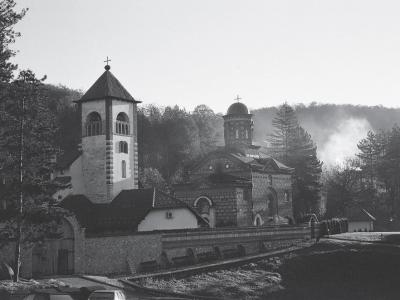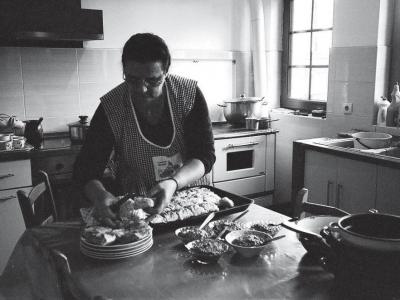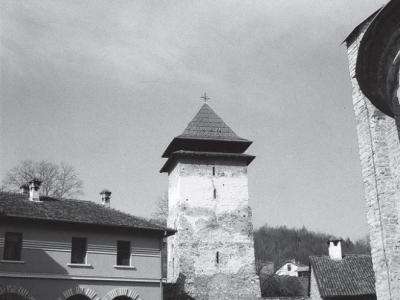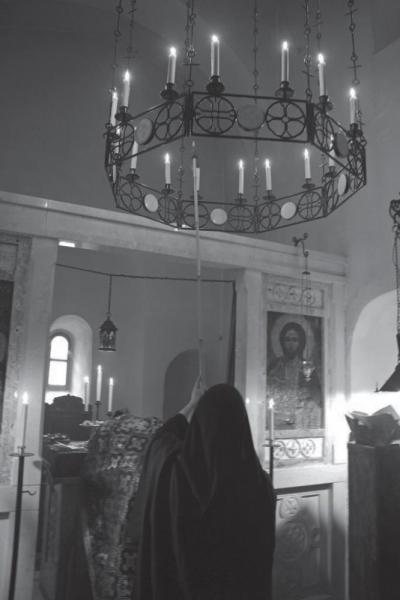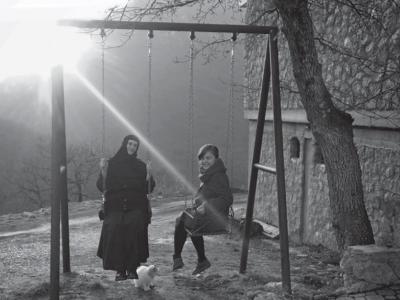The Gift
Zuzana Gogová
This text is based on the field research I conducted in Serbia for my master’s thesis. The main goal was to better understand and describe material and non-material cooperation and exchange between Eastern Christian Orthodox worshipers and monastery communities of monks and nuns in the rural regions of Serbia. My experience in one of the Serbian monasteries in August 2014 was one of the impulses for this subject. Openness and hospitality in a relatively poor rural region where the soil and domestic animals provide the primary source of living motivated me to think more about forms of sharing, exchange, expectations... In general, whether the relationship of Serbian worshipers to monks and nuns in monasteries can be looked at even from the perspective of mutually exchanged items or gifts. I returned several times to the monasteries in the autumn of 2014 and the late spring of 2015. The main concept of this work through which I tried to understand and describe in greater detail the relationship between worshipers and the monastery community, monks and nuns, was the concept of gifts (we shall also encounter the term “the gift economy”) and reciprocity.
Several Explanations of Gift
This essay will examine several approaches of authors to gifts and reciprocity in society followed by a description of part of my research in Serbia. Due to the space constraints of this essay, this description provides only a fragment of the information required to really understand the position of gifts among Eastern Christian orthodox worshipers and the monastery communities in Serbia. Therefore I would like to emphasize here that location, cultural conditions and other historical and economic aspects form the social relationships and how they are manifested. Therefore, this phenomenon has a specific and unique form in Serbian life and customs , and rather than discouraging, it motivates thoughts about gift-giving and open- ness to others (which is related to it) under these conditions.
Based on the knowledge of other cultures and analyses of the long-term historical development of progress in the West, a group of scientists from the fields of anthropology, ethnology, sociology and economy have come up with the opinion that interpersonal relationships are not only a result of the effect of economic and strategic powers, but that people create bonds which are part of more complex social relationships. Their opinion is just the opposite of what the theory and practice of the main economic stream understands under the notion homo oeconomicus, i.e., a human being guided by market laws and principles. They also claim that in addition to classical business relationship based on the requirements of profit, growth and prosperity, there existed and still exists a relationship among people, the essence of which is reflected in the disturbance of the traditional scheme of the market, the scheme of individualism, capitalism, etc. Its essence lies in a certain form of giving and the reciprocal circulation of gifts, i.e., items mutually exchanged among the individuals of a society or its groups. In short, people do not have to primarily look for their own bene- fit in mutual relationships; they are motivated by a concept that is not based on primary economic goals or profit at various levels. This type of mutual relationship is affected by bilateral interest, trust and cooperation as well as dependence. As Polanyi (2001) writes, it is an economic system maintained by “non-economic motives” but primarily by the social bonds which it creates through “relative” economic processes. In the wordsof Polanyi the “economic system is in fact only a social constitution activity” in such communities (ibid.). Most frequently this pertains to tribal communities where the good of the community is placed before individual needs and motivations. The good of a community is strengthened by a large number of social activities such as sharing common food accompanied by specific rituals. In a certain sense, a gift is the guarantee thanks to which the system of social relationships can function. A gift opens alliances, creates solidarity and community and therefore ensures peace. Komter (2005) claims that societies which lack the manifestation of gratitude are bound for extinction and that power and dependence are the points of contact for gratitude and its opposite. Communal sharing proves that they are based on an “equality relationship in which people care for membership in the group while individuality and the defined identity of persons are not very obvious.” (ibid.).
Identification with community and the feeling of belonging, interest and care, solidarity and relationships on the basis of friendship represent the cardinal elements of communities (ibid.). Bronislaw Malinowski (1920), who studied the indigenous people of the Trobriand Islands, claimed that gift-giving and repaying for a gift form the basis for reciprocity1. According to Malinowski the gift “relates to all communities and fully includes each community.” (ibid.).
According to several authors, a community’s internal commitments weaken in the process of a society’s development and due to a division of labor which occurs during the transition from a traditional to a modern society with the development of industry, primarily in so called Western countries. In the 1940s, Karl Polanyi in his work The Great Transformation (2001 [1944]) pointed out the negatives in transformation processes connected with the industrial revolution and business which had an impact on the form of social relationships. Therefore, the basic principle I work with in this thesis is the claim that the economic system of a certain society must be analyzed as a whole and as a historically special social contract maintained through common activities within a community; for example, in the case of tribal communities, this is exhibited in ceremonial food sharing, communal work or magical acts which according to Polanyi are fulfilled in the process of redistribution and reciprocity.
Goudbout (2000) defines gift more explicitly when he criticizes the works of certain social sciences theoreticians, who, while striving to logically explain the gift, reduce it to the outcome of strategies implemented with a view to achieving the most satisfying rewards at the material level; he tries to point out that gift and reciprocity are not political, economic or any other instrument used for gaining profit, but play a role in interpersonal relationships. In his view, gift-giving is “not an economic but a social system related to personal relationships” (ibid.). Goudbout (2000) and Komter (2005) most obviously and perhaps with a
certain degree of hope, state that gift-giving and reciprocity as a form of non-monetary exchange and with deeper significance for social relationships have their place not only in archaic cultures, but that gift-giving (e.g. in the form of voluntary help, donating blood or organs, public collections, donating food and others) is also part of the modern world.
Several Findings From Field Research
During my anthropological research in Serbia I focused on describing the main motivations of worshipers to give gifts to monks and nuns in monasteries, trying to understand the nature of mutual relation- ships among the worshipers and monastery communities (with their reciprocal nature). Moreover I was interested in what maintains these relationships and those aspects thanks to which the reciprocal relationships have been legitimized. However, these findings are not final. I am certain that field research would offer baseline points for other questions during every such trip and it would not have to pertain to the location of the monasteries, but simply to places and people where they regularly operate.
When thinking about the analyzed worshiper – monk/nun relationship I realized that their world is not only limited to the presence of persons as such, but it is necessarily related to a third subject which is present (and has an impact on the form of this relationship). This can be God, a saint or a person who played an important role in the history of the Eastern Christian Orthodox Church or in relation to the church or nation. Worshipers referred to these subjects even with respect to the fact that the roots anddevelopment that comprise the Eastern Christian Orthodox church in the territory of Serbia had a connotation of forming a national identity in addition to the authority of the saint. One of the nuns told me: “to live for 500 years under Turkish oppression is very difficult, but faith was a tower of strength for us, namely Eastern Orthodox Christianity. Christianity in fact redeemed us and we remained who we are today because in fact it is all about faith – the fundamental stone of everything that shall remain.”
People frequently brought food staples (oil, sugar, coffee, wine) to monasteries, placing them in front of icons or literally donating them to the saint who was present in the monastery in the form of an icon. As one of the monks explained to me “each monastery is built around a church consecrated to a certain saint. People bring it as a contribution to this sacred place. They bring it in this context and that is also how we perceive it. It means they are not personal gifts.” But this is not always the rule; for example, people often see a specific monk or nun and ask them for a prayer and hand a gift directly to him or her. On the other hand, the worshipers frequently stated that for example a blessing which they received from the monk or nun or a prayer for their life or love which according to the words of one of the participants, are the gifts which they receive. He specifically said: “I think that in the monastery a person can find love, satisfaction, they can obtain peace and the will to continue in life. They can find joy.”
In addition to non-material gifts, every single monastery community was ready to help or donate a part of their material resources according to their possibilities.2 I think that in this context I directly veri- fied what I was studying, since during my research I lived, ate, observed and talked with nuns and monks directly in their monasteries.3 At the same time, I was aware of one aspect, namely that I did not have many opportunities to repay them for their assistance, and despite the fact that I was their guest as they frequently used to say. When leaving one of the monasteries to which I returned several months later, the supreme monk handed me an envelope and asked me to open it only when I got home. Following his instructions, I opened the envelope at home and found money inside. My “ratio” naturally did not understand why somebody, to whom I should be in debt, gave me money. When I returned to that monastery I asked the monk why he gave me the money. He replied by telling the Bible story about the motivation to give from an honest heart. If he had tried to explain his actions today, I would not be able to comprehend them logically just as before maybe, (even) because irrationality is a feature of the gift. One of the worshipers defined this irrationality by love when he said that when giving a gift to the monastery he “expects nothing because this is his expression of love for God and love should not expect anything in return,” which only confirms the claim by Goudbout (2000).
I am convinced that regardless of whether we believe in God or not, whether we live in Slovakia or elsewhere, we have the option to choose the basic principles that will form our position in society, not by being separate from it, but by becoming part of it and thus searching for possible ways to form this society into a more coherent and synergic whole, despite our differences.4 My experience from Serbian monasteries showed me that relationships do not have to be complicated, but the willingness to give to and receive from others5 will indirectly lead us to more sincere relationships.
Bratislava, 2016
– – –
(1) Certain authors consider reciprocity undesirable with respect to the fact that it disturbs the anti-utilitarian nature of a gift since it appears to undermine the sincere nature of the first donor.
(2) This could be either using a car to take a man from the village to the hospital, offering to help pay for a boy’s operation or simply offering food to the poor or travelers.
(3) They accepted me for a couple of days and tried to understand why I travelled through Serbian monasteries. In striving to be objective I must admit that there were certain monasteries where I could not stay for various reasons.
(4) One of the differences between me and monastic communities was religion, but the willingness of monastic communities and the faithful opened our mutual space despite the (relatively) substantial differences. Old monk, igumen (monk superior) told me in an interview: “We meet, we are happy and that is what has meaning for us. Thus, we also accept you, Zuzana. We did not know you, but we love you as if you were our own. “
(5) It was during my trip to Serbia when I was dependent on help of others either in the form of accommodations, orientation, recommendations regarding monasteries to visit, etc.
SOURCES:
GODBOUT, Jacques T. 2000: The World of the Gift. Canada: McGill-Queen’s University Press. KOMTER, E. AaThe. 2005: Social Solidarity and the Gift. Cambridge: Cambridge University Press.
MALINOWSKI, Bronislaw. 1920: Kula; The Circulating Exchange of Valuables in the 64 Archipelagoes of Eastern New Guinea. In: Man, Vol. 20. (Jul., 1920), pp. 97-105.
POLANYI, Karl. 2001: The Great Transformation. The Political and Economic Origins of Our Time. Boston:
Beacon Press.
BIO:
Zuzana Gogová finishied cultural studies at Comenius University in Bratislava and environmetal studies at Masaryk University in Brno. Her heart and mind is mostly focused on discovering small communities/societies with ways of life, which have strong connection with the Earth.
